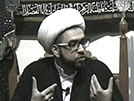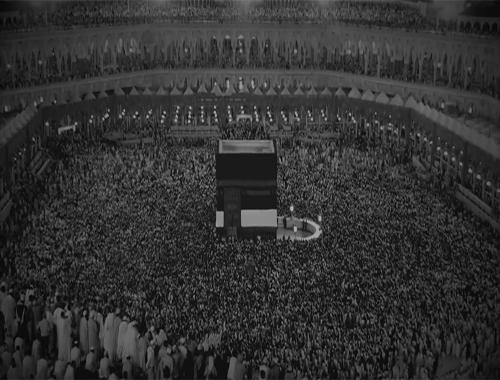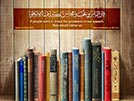The Method of the Interpretation of the Qur'an
- Details
- Hits: 3116
The Method of the Interpretation of the Qur’an
The twentieth century (1400 A.H.) began with the awakening of the East and its peoples, particularly the Muslims. The charm of colonialism has somewhat broken down and the colonized countries have become independent or half-independent. Muslims and Muslim scholars started to think over a set of fundamental issues, including the causes of their weakness and backwardness, and came to seek a remedy for it.
The spread of the Qur’anic teachings, sciences and truths were given much more attention than other issues. For, in the earliest centuries, the scientific truths of such a revealed Book were only known by the scholars, while the other classes of the society contented themselves with the reading and reciting of its text. At that time, they used to work on tajwid (a discipline dealing with how one is required to recite the Qur’an in accordance with certain established rules) and reading through the text more than they did on the exegesis and understanding of the Qur’an. Exegetical books were written for the class of the experts in particular. However, few books were written, just as few gatherings were held, for the guidance of the other classes. It seems that what scholars were interested in were contemplation and reflection on the verses of the Qur’an, while other members of the society were merely involved in reading and reciting the holy text.
Not only had such a procedure brought about several harmful consequences identified by the later scholars, it was also contrary to the very explicit text of the Qur’an which calls all people to a deep understanding of the meanings of its verses. The Qur’an is introduced by itself as the burning torch, the best guide, the guide for the Godwary, and a reminder.
فَمَالَهُمْ عَنِ التَّذْكِرَةِ مُعْرِضِينَ،كَأَنَّهُمْ حُمُرٌ مُّسْتَنفِرَةٌ، فَرَّتْ مِن قَسْوَرَةٍ
“What is the matter with them that they evade from the Reminder, as if they were terrified asses, fleeing from a lion”[1]
Those verses that call the Godwary, the intellectuals, and the thinkers to listen to the Qur’an and to think deeply over its meanings are too many to be cited here. Mention, however, can be made to one example:
وَلَقَدْ يَسَّرْنَا الْقُرْآنَ لِلذِّكْر فَهَلْ مِن مُّدَّكِرٍ
“Certainly We have made the Qur’an simple for the sake of admonishment. So is there anyone who will be admonished?” [2]
The foregoing and many similar verses suggest that understanding the Qur’an and making use of it are not confined to a single particular group. To overlook, the masses of the society from making use of the Qur’an is irreconcilable with the very text of the Qur’an.
Accordingly, the popularity of the sessions on the interpretation of the Qur’an counts as one of the basic changes occurred to the Qur’anic studies at the beginning of the 14th century A. H. . Many Interpretations were written just as many sessions were held in different Islamic countries such as Egypt, Syria, Iraq, Pakistan, and Iran in order to acquaint common people with the Qur’an.
We are, therefore, required to introduce the best method of interpretation of the Qur’an to help those interested to better understand its concepts and doctrines. Having done his best and evaded following the others blindly, the true interpreter is required to observe the following principles:
1. Familiarity with Arabic Language and Grammar
A primary prerequisite for the interpreter of the Qur’an is to be perfectly familiar with the rules of Arabic language in order to be able to distinguish the subject from the object, adverbs denoting time or place from the words to which they belong, the participial phrase from the agent to whom it belongs, the coordinated phrase from that which precedes it, and so forth. It is necessary for understanding any book to be familiar with the grammar of its language. Many misunderstandings in relation to the verses of the Qur’an stem from unfamiliarity with the rules of Arabic language. However, it is not necessary to be an expert in the rules of Arabic, i.e. its derivations, morphology, and grammar. All what the interpreters need in this regard is the ability by which they can distinguish such issues, which may cover a few courses in the relevant rules.
2. Familiarity with the Meanings of the Terminology of the Qur’an
Acquaintance with the terminology of the Qur’an is one of the prerequisites for the Qur’an interpretation. We cannot understand the compounds unless we understand their parts.
It must be borne in mind that we can never interpret the verses of the Qur’an thereby relying on the meanings of Arabic words recurrent today in our minds, For many words have changed their meanings through history! It is therefore necessary to study the roots of the words and their original meanings. The words, for example, “asa” (to disobey) and “ghawa” (to go amiss) today mean “to commit sin”; however, the origins of these words have a meaning different from what is recurrent in our minds today.
Having supposed that “asa” and “ghawa” have the same meaning at the time of the prophetic mission as that of the present, some people proceed to argue that the verse:
وَعَصَى آدَمُ رَبَّهُ فَغَوَى
“Adam disobeyed his Lord and went amiss” [3]
proves the fallibility of the prophets. If, however, we make a good research on the origins of the two terms, we will see that they used to convey meanings different from what is meant today, though derived from those earlier meanings. At that time (ethical) disobedience never used to be implied by the two terms.
The most important book that can help us be familiar with the roots and original meanings of the Qur’anic terminology is al-Maqayys by Ahmad Ibn Faris Ibn Zakariyya (D. 359 A. H.). This book has been published in six volumes in Egypt. The author has done his best to provide the reader with the original meanings of the terms. He then goes on to remind us of how other meanings are gradually derived from those roots appearing as independent words with new meanings.
In Arabic dictionaries one can find one entry with ten meanings, and one may suppose that each of those meanings are postulated separately for the word. When, however, one refers to al-Maqayys, one comes to know that the word has no more than one meaning from which other meanings have progressively been derived, appearing as an independent word with a new meaning.
In addition to this book, one is to consult other similar Arabic dictionaries such as al-Mufradat fi Gharib al-Qur’an by Abu al-Qasim Hussein Ibn Muhammad known as Raghib Isfahani (D. 502 A.H.), al-Nihaya fi Gharib al-Hadith wa al-Athar by Majd al-Din Abu al-Sa’adat Mubarak Ibn Muhammad Jazari known as Ibn al-Athir (B. 544 and D. 606 A. H.), published in six volumes in Egypt. This book deals with the strange terminologies of the traditions, yet it can help us better understand the interpretation of the Qur’an, too. Majma’ al-Bahrayn by al-Turayhi al-Najafi (D. 1086) is also a good reference for the interpretation of the terminology of the Qur’an.
3. The Interpretation of the Qur’an by the Qur’an
The Qur’an introduces itself as the explanation of all things, where it says,
وَنَزَّلْنَا عَلَيْكَ الْكِتَابَ تِبْيَانًا لِّكُلِّ شَيْءٍ
“We have sent down the Book to you as a clarification of all things” [4]
If the Qur’an is the clarification of all things, then it must naturally be able to clarify itself. If there is an advantage that requires the presence of ambiguity in a verse, this ambiguity can be ‘lifted’ by other verses revealed on similar contexts.
As regards the people of Lot, for example, Allah says:
وَأَمْطَرْنَا عَلَيْهِم مَّطَرًا فَسَاء مَطَرُ الْمُنذَرِينَ
“And We rained down upon them a rain. Evil was the rain of those who were warned”.[5]
This verse talks of a rain in general, so it is not clear whether it refers to water or stones. However, the foregoing ambiguity disappears through another verse:
وَأَمْطَرْنَا عَلَيْهِمْ حِجَارَةً مِّن سِجِّيلٍ
“And We rained on them stones of shale” [6]
Another instance of such ambiguity occurs in the following verse:
هَلْ يَنظُرُونَ إِلاَّ أَن يَأْتِيَهُمُ اللّهُ فِي ظُلَلٍ مِّنَ الْغَمَامِ وَالْمَلآئِكَةُ وَقُضِيَ الأَمْرُ وَإِلَى اللّهِ تُرْجَعُ الامُورُ
“Do they await anything but that Allah should come to them in the shades of the clouds, with the angels, and the matter be decided. And to Allah all matters are returned.” [7]
The Jews expect Allah to come to them in the shades of the clouds, but the matter has already been decided. The external sense of the verse is ambiguous, for going to or coming from somewhere can only be applied to the bodily characteristics from which Allah is far above and free. This ambiguity has been removed by Surah al-Nahl, verses 33-34, revealed on the similar context, suggesting the going and coming of the edict of Allah in cases of punishment, torments, etc.
هَلْ يَنظُرُونَ إِلاَّ أَن تَأْتِيَهُمُ الْمَلائِكَةُ أَوْ يَأْتِيَ أَمْرُ رَبِّكَ كَذَلِكَ فَعَلَ الَّذِينَ مِن قَبْلِهِمْ وَ مَا ظَلَمَهُمُ اللّهُ وَلكِن كَانُواْ أَنفُسَهُمْ يَظْلِمُونَ
“Do they await anything but that the angels should come to them, or your Lord’s edict should come to them? Those who were before them had acted likewise; Allah did not wrong them, but they used to wrong themselves.” [8]
This verse has obviously clarified that the real subject of “come” is “Allah’s edict”, not Allah the Almighty.
This method (interpretation of the Qur’an by the Qur’an) has been established and followed by the infallible Imams and applied by the interpreters nowadays.
In his al-Mizan, one of the greatest Shiite interpreters of the Qur’an, late ayatollah Sayyid Muhammad Husayn Tabataba’i has made use of this method, that is different from “the attention given to the harmony of the total verses of the Qur’an” which is to be discussed later. The former aims at clarifying ambiguity through another verse, while the latter suggests that in understanding any verse, whether or not there is ambiguity, we ought not to ignore other related verses; and the difference between these two matters is so clear.
4. The Occasions of Revelation
Following a series of events and questions, the Qur’an was revealed within 23 years. Knowledge of the occasions of revelation helps to clarify the meaning of the verse. However, this does not mean that we cannot attain the real meaning of the verse without considering its occasion. As proved by such verses as:
هُدًى لِّلنَّاسِ وَبَيِّنَاتٍ مِّنَ الْهُدَى وَالْفُرْقَانِ
“As guidance to mankind, with manifest proofs of guidance and the Distinguisher” [9]
وَأَنزَلْنَا إِلَيْكُمْ نُورًا مُّبِينًا
“And We have sent down to you a manifest light” [10],
the verses of the Qur’an count as “guidance” and “proofs of guidance” and “the Distinguisher”. Accordingly, these verses are clear and understandable, and can still be clearer and more obvious with the help of the occasions of revelation. Mention, for example, can be made to the following verse:
وَعَلَى الثَّلاَثَةِ الَّذِينَ خُلِّفُواْ حَتَّى إِذَا ضَاقَتْ عَلَيْهِمُ الأَرْضُ بِمَا رَحُبَتْ وَضَاقَتْ عَلَيْهِمْ أَنفُسُهُمْ وَظَنُّواْ أَن لاَّ مَلْجَأَ مِنَ اللّهِ إِلاَّ إِلَيْهِ ثُمَّ تَابَ عَلَيْهِمْ لِيَتُوبُواْ إِنَّ اللّهَ هُوَ التَّوَّابُ الرَّحِيمُ
“And to the three who were left behind. When the earth became narrow for them with its expanse, and their souls weighted heavily on them and they knew that there is no refuge from Allah except in Him, then He turned clemently toward them so that they might be penitent. Indeed Allah is All-clement, All-merciful.” [11]
The meaning of the verse is undoubtedly obvious; nevertheless, we are eager to be informed of the following questions:
1. Who were these three people?
2. Why were they left behind?
3. How did the earth become narrow for them?
4. How did their souls weight heavily on them, and were depressed?
5. How did they know that there was no refuge except in Allah?
6. What is meant by the happy outcome with regard to the three men?
The answer to each one of the aforesaid questions can be taken from the occasions of revelation.
It is noteworthy, however, that many occasions of revelation cited in the books of interpretation are not reliable. In order to rely on those cases, we should follow some established rules and standards so as to distinguish the accurate from the inaccurate ones. We should, in particular, be cautious about the occasions of the stories of the Qur’an concerning the holy prophets and earlier people. For many of these occasions are recounted by unreliable people, Jewish or Christian scholars who can never be entrusted with their historical quotations. Having failed to observe those rules, some interpreters have loaded up their works with many occasions of revelation related by unreliable people.
5. Referring to the Sound Traditions
A cluster of the verses of the Qur’an contain revealed laws on what one is required to do or not to do, known as the verses of the rulings. The number of these verses is not few, and some interpreters have added them up to 500 verses. Although the number of these verses may be less than that, we will fail to make use of them without referring to the relative sound traditions, because these verses are absolute or general while their relevant conditional and particular case have been stated thereafter in the traditions of the holy Prophet and his Infallible Successors (the Imams). To demonstrate a law through those general or absolute verses would be invalid unless we refer to the particularities and the conditional stated in the holy traditions.
In order to further explain the issue, we may add:
1.The Qur’an includes numerous issues whose details can holy be found in the Islamic traditions and the practice of the Muslims. The Qur’an, for example, has imposed salat (prayer), sawm (fasting), zakat (alms), khums (one fifth tax), and hajj (pilgrimage) on Muslims, but it has left the details to the Islamic traditions as well as the practice of the Muslims. Without referring to those traditions and practices any explanation and interpretation of the verses would be impossible. Such is the method of the interpretation embraced by all Muslims since the appearance of Islam up to now.
2.There are many absolute and general verses in the Qur’an, the conditionals and particularities of which can only be found in the traditions of the holy Prophet and Infallible Imams. Not only is this method found in the Qur’an, it can also be seen in all legislative systems throughout the world. This means that many remarks and exceptions will, with the passage of time, be added to the ongoing laws of a given country. The difference, however, between the verses of the Qur’an and human positive laws lies in the limitedness of human knowledge, which gives rise to the separation of remarks from the principles (positive laws); these remarks will later and gradually either include other cases or exclude them from the principles. Yet, this is not the case with divine legislation. For all the details pertaining to whether the future cases would be included in or excluded from the law are known by the Legislator, Allah. However, some social issues require that the particularities of the laws be articulated gradually and not at once. Usury, for example, is prohibited by the Qur’an:
وَحَرَّمَ الرِّبَا
“And [Allah has] forbidden usury”.[12]
Yet, a few cases of usury have legally been considered permissible through the Islamic traditions such as usury between father and his son, between husband and wife. The wisdom beyond the permissibility of these cases is clearly the fact that the common fund of the two sides would not let any one exploit the other.
As requested by the verse:
وَمَا آتَاكُمُ الرَّسُولُ فَخُذُوهُ وَ مَا نَهَاكُمْ عَنْهُ فَانتَهُوا
“Take whatever the Prophet gives you and relinquish whatever he forbids you” [13], we have to embrace all orders of the holy Prophet and refrain from what he has prohibited. As to the interpretation of such verses which are not few in the Qur’an, if the interpreter wants to be content with the Qur’an itself, without referring to the traditions, he will oppose the foregoing verse.
The need for the verses of the rulings in the traditions has made some legal authorities write separate books on this sort of the verses known as “Tafsir Ayat al-Ahkam”. Mention, as the best works in this regard, can be made to those by al-Jassas, al-Fadil al-Miqdad, al-Muhaqqiq al-Ardabili, and al-Jaza’iri.
Some Proofs from the Qur’an:
The foregoing is an undeniable fact, felt by every interpreter and embraced by all realistic men. Furthermore, the Qur’an itself testifies clearly that it is in need of the holy Prophet’s expositions. For, in addition to the recitation of the Qur’an the, the prophet is required to explain what is meant by its verses. Here we would just refer to some instances and leave out the details.
وَأَنزَلْنَا إِلَيْكَ الذِّكْرَ لِتُبَيِّنَ لِلنَّاسِ مَا نُزِّلَ إِلَيْهِمْ وَلَعَلَّهُمْ يَتَفَكَّرُونَ
1. “We have sent down to you the Reminder so that you may clarify (litubayyina) for the people that which has been sent down to them, so that they may reflect.” [14]
should one distinguish “clarify” (litubayyina) from “recite” (litaqra’a), one would come to understand what we claim. Through this distinction, one would know that the holy Prophet has two different missions:
1. The recitation of the verses of the Qur’an;
2. The clarification and exposition of the verses of the Qur’an.
This verse, nevertheless, suggest that not all the verses of the Qur’an are in need of clarification. Rather the verses whose purport or particularities are unattainable stand in need of the prophet's or his successors’ interpretation as is the case with the verses of the rulings.
لَا تُحَرِّكْ بِهِ لِسَانَكَ لِتَعْجَلَ بِهِ،إِنَّ عَلَيْنَا جَمْعَهُ وَقُرْآنَهُ،فَإِذَا قَرَأْنَاهُ فَاتَّبِعْ قُرْآنَهُ،ثُمَّ إِنَّ عَلَيْنَا بَيَانَهُ
2. “Do not move your tongue with it to hasten it. Indeed it is up to Us to put it together and to recite it. And when We have recited it, follow its recitation. Then its exposition indeed [also] lies with Us.” [15]
Allah, in this verse, has undertaken three matters:
1. The recitation of the Qur’an;
2. The collection of its verses
3. The exposition of its meanings, which can only be possible through revelation to the holy Prophet.
Revelation will never occur to people directly, or rather it pertains to the holy Prophet just as its contents are reflected in the form of the Qur’an or the practice of the Prophet. As to the clarification of the meanings of the Qur’an, we have no choice but to refer to the foregoing two references. Moreover, Allah has prohibited the holy Prophet from hastening to recite the Qur’an, for Allah has assumed the collection of the Qur’an and its recitation to the holy Prophet, commanding him to follow its recitation, and then He has taken its exposition upon Himself.
What is meant by exposition is not the articulation of words which has already been mentioned by “Indeed it is up to Us to put it together and to recite it”-there is no need for the repetition. The meaning of the exposition is, indubitably, the explanation of the meanings which can only be carried out by Allah and the holy Prophet who, in his turn, receives those meanings through revelation, in addition to his true successors who are in their turn, entrusted with them. However, not all the verses of the Qur’an stand in need of exposition, so it is not valid to ask what the exposition of the verse: “Indeed Allah is all-powerful” is. What we want to say here is that the Qur’an as a whole is in need of exposition from the holy prophet’s traditions, but whether all or some verses need such an exposition is another issue. Moreover, as mentioned before, only those traditions whose transmitters are veracious and whose denotations are valid can be relied upon in explaining the verses of the Qur’an.
6. The Harmony of All Verses as a Whole
What has been stated so for represents the very foundation of the interpretation of the Qur’an. The prerequisite for the accuracy and strength of the interpretation is that the interpreter should observe the systematic harmony of a given verse with other verses, whether related to the same chapter or other chapters of the Qur’an. The interpreter should know that all verses of the Qur’an follow single purposes incorporated in a closely connected, yet superior, one.
Here is the main slippery instance of interpretation where many, who know Arabic grammar but because they have failed to take into consideration all similar verses on the same issue, make mistakes. Such mistakes have brought about different schools and various doctrines, each of which refers to the Qur’an to support their beliefs.
All founders of Islamic schools and theories -whether Mujabbira (determinists), Mushabbiha (anthropomorphists), Mujassima), Mu‘tazilites, Murji’ites, and the like-resort to different verses of the Qur’an to prove their own schools and views even though, from among all those schools only, one is true and the rest are wrong and deviating from the Qur’an.
When we proceed to find out the causes of the emergence of such deviated schools, we will see that each school has adhered to a single verse but failed to take into consideration similar verses revealed on the same topic. There are a few verses which, taken separately, might lead us to determinism, human free-will, anthropomorphism, etc. Nevertheless none of such contradictory views can be ascribed to the Qur’an that says:
وَلَوْ كَانَ مِنْ عِندِ غَيْرِ اللّهِ لَوَجَدُواْ فِيهِ اخْتِلاَفًا كَثِيرًا
“Had it been from [someone] other than Allah, they would have surely found much discrepancy in it.” [16]
This paradox could only be solved if we merely pay attention to the harmony and coherence of the verses of the Qur’an that describes itself as possessing two characteristics:
1. The verses are similar to one another
2. The motifs of the verses are reiterated.
اللَّهُ نَزَّلَ أَحْسَنَ الْحَدِيثِ كِتَابًا مُّتَشَابِهًا مَّثَانِيَ
“Allah has sent down the best of discourses, a scripture of similar verses [and of] reiterated motifs” [17]
It is natural that two similar things, although they may contain some points of difference in some respects, share numerous points of resemblance. Through the foregoing common aspects we have no choice but to take into consideration all similar verses when we want to attain the true interpretation of any verse. The case is true of any issue whose motifs are reiterated in various contexts.
The need for another method of the interpretation of the Qur’an known as al-tafsir al-mawdu‘i, “the interpretation according to the subject matter” becomes evident. In such a method, the interpreter is required to collect all the verses revealed on the same issue as far as he could; he then proceeds to compare the verses and applies them in order to take an integrative outlook. However, a much more useful method of interpretation for some people is “the by chapter by chapter interpretation” which has its own benefits. Still, to reveal the true meanings of the verses comprehensively, there is no(better) choice than “the interpretation according to the subject matter” which mainly represents the spirit of “the harmony and coherence of the verses”. Even though it is not devoid of defect, the foregoing method has been applied by the author of the present essay in his Manshur Javid Qur’an and Mafahim al-Qur’an.
7. Attention to the Context of the Verses
Taking into account the context, i.e. the preceding and succeeding verses, counts as a part of the sixth prerequisite, namely the harmony of all verses as a whole. To pay attention to a single verse and close the eyes in relation to the other verses on the same topic, would not lead but to a big mistake and deviation from what the Qur’an means. Not only does the foregoing apply to the Qur’an, the interpretation of the words of every wise man depends on considering all the preceding and succeeding words of his speech as a whole.
In Surah al-A‘raf 7: 35, for example, Allah says:
يَا بَنِي آدَمَ إِمَّا يَأْتِيَنَّكُمْ رُسُلٌ مِّنكُمْ يَقُصُّونَ عَلَيْكُمْ آيَاتِي فَمَنِ اتَّقَى وَأَصْلَحَ فَلاَ خَوْفٌ عَلَيْهِمْ وَلاَ هُمْ يَحْزَنُونَ
“O children of Adam! If there come to you prophets from among yourselves, recounting to you My signs, then those who were Godwary and righteous will have no fear, nor will they grieve” [18]
Having disregarded the context and separated it from the preceding and succeeding verses, this verse would suggest that a few prophets would come after the holy Prophet Muhammad (p.b.u.h), while another verse describes him as the last prophet with whom the prophetic mission has ended for ever. The Qur’an says:
مَّاكَانَ مُحَمَّدٌ أَبَا أَحَدٍ مِّن رِّجَالِكُمْ وَلَكِن رَّسُولَ اللَّهِ وَخَاتَمَ النَّبِيِّينَ وَكَانَ اللَّهُ بِكُلِّ شَيْءٍ عَلِيمًا
“Muhammad is not the father of any man among you, but he is the Prophet of Allah and the Seal [last] of the prophets, and Allah has the knowledge of all things.” [19]
The reason for this misunderstanding is that the context of the preceding and succeeding verses is disregarded in the interpretation of the verse. If, nonetheless, we refer to the very Qur’an, we see that, along with this verse, the whole twenty six verses of Surah al-A‘raf speak about an event at the beginning of the creation of mankind, i.e. the story of the creation of Adam, his expulsion from Eden, and his falling onto the earth with his children. Concerning the foregoing event, Allah said to the children of Adam that if some prophets came to them and they were Godwary, they would have no fear nor would they grieve.
After Adam had settled down on the earth, many prophets came to guide people to the right path, the message of all was that
فَمَنِ اتَّقَى وَأَصْلَحَ فَلاَ خَوْفٌ عَلَيْهِمْ وَلاَ هُمْ يَحْزَنُونَ
“those who were Godwary and righteous will have no fear, nor will they grieve” [20]
The story of the beginning of creation does not put an obstacle in the way of the holy Prophet Muhammad and his last message with which the long line of prophetic missions has ended. This issue will become more evident if we know that the Qur’an has, in the twenty six verses of al-A‘raf, addressed the children of Adam three times by “O children of Adam” as follows:
يَا بَنِي آدَمَ قَدْ أَنزَلْنَا عَلَيْكُمْ لِبَاسًا
1. “O children of Adam! We have certainly sent down to you garments …”[21]
يَا بَنِي آدَمَ لاَيَفْتِنَنَّكُمُ الشَّيْطَانُ كَمَا أَخْرَجَ أَبَوَيْكُم
2. “O children of Adam! Do not let Satan tempt you, like he expelled your parents from paradise…”[22]
يَا بَنِي آدَمَ إِمَّا يَأْتِيَنَّكُمْ رُسُلٌ مِّنكُمْ
3. “O children of Adam! If there come to you prophets from among yourselves…”[23]
In another occurrence where the Qur’an wants to talk about the beginning of the creation, it has also made use of the expression “O children of Adam”:
أَلَمْ أَعْهَدْ إِلَيْكُمْ يَا بَنِي آدَمَ أَن لَّاتَعْبُدُوا الشَّيْطَانَ
“Did I not exhort you, O children of Adam, saying, ‘Don’t worship Satan…”[24]
Such a kind of vocative can only be appropriate for the beginning of the creation, not the time of the holy Prophet.
It thus becomes clear that the reason for misunderstanding is inattention to the contexts, which show that this verse pertains to the beginning of the creation, and does not belong to the “termination of the prophetic mission”.
8. Familiarity with the Relevant Views
One of the important bases of the interpretation of the Qur’an is familiarity with the views of Muslim interpreters who have spent their lives on the interpretation of the Qur’an and become the true masters at this work.
Having known the laws and circumstances, the people at the time of the revelation could easily understand the concepts of the Qur’an verses without any need for such views. However, because we are far away from that time and have naturally missed those social contexts, we cannot embark on interpreting the Qur’an without our acquaintance of those views.
The view of a group is better, safer, and more reliable than that of a single person. This fact, however, does not mean that we would lose our intellectual independence and become absorbed in the views of other people. Rather, when we interpret any verse, we ought not to overlook the other views, for very often they would help us find our faults or help deduce the correct conclusion.
When is the interpreter required to consult the views of the others? Is it after he does his own research or before? For the beginners the former alternative will be better, but for the experts the latter would do, for quite often the familiarity with the other views has prevented the experts from doing their own research and study.
9. Keeping away from any Prejudgment
Having their mind structured in preconceptions and prefabricated ideas to support their own views, some interpreters are not able to get the true meanings and purposes of the Qur’an. A good interpreter is required to look at the Qur’an with complete neutrality and without prefabricated ideas of any kind in order to attain the true meanings of the Qur’an. On this basis, any presupposed stand is like an obstacle between the interpreter and the true meanings of the Qur’an. Instead of adapting his views for the Qur’an, the foregoing would lead the interpreter to adapt the Qur’an to his views and cause him to teach, rather than learn from, the Qur’an.
All Muslim transmitters of Hadith have reported the following tradition from the holy Prophet:
من فسر القرآن برأيه فليتبوء مقعده من النار
“Whoever interprets the Qur’an according to his own opinion, let him take over his seat in Hell.” [25]
What the holy Prophet means by “the interpretation according to one’s own opinion” is not but the interpretation according to the prefabricated opinions, without referring to the Qur’an itself, or the sound traditions.
The interpretation of the Qur’an according to the Qur’an itself, just as when one interprets an ambiguous verse with the help of another clearly established one, is not only acceptable but also different from “the interpretation of the Qur’an according to one’s opinion”.
10. Familiarity With Scientific and Philosophical Insights
Familiarity with philosophical views on tawhid (monotheism), divine attributes and actions and the like as well as what is going on in the realm of science makes our minds thrive and achieve a deeper and better understanding of the Qur’an.
Nowadays, many great steps have been taken in relation to the earth, the cosmos, animals and human beings, and many new horizons have been discovered in sociology and psychology. It is true that nobody can claim that whatever is said in this regard is correct; nonetheless, familiarity with such new discoveries may strengthen our scientific and philosophical thoughts and cause the minds of the interpreters to flourish, so that they could make use of the Qur’an in everyway possible.
Mention, for example , may be made to the six verses at the beginning of Surah al-Hadid, out of which we refer to two of them alone:
هُوَ الأَوَّلُ وَالْآخِرُ وَالظَّاهِرُ وَالْبَاطِنُ وَهُوَ بِكُلِّ شَيْءٍ عَلِيمٌ، هُوَ الَّذِي خَلَقَ السَّمَاوَاتِ وَالْأَرْضَ فِي سِتَّةِ أَيَّامٍ ثُمَّ اسْتَوَى عَلَى الْعَرْشِ يَعْلَمُ مَا يَلِجُ فِي الْأَرْضِ وَمَا يَخْرُجُ مِنْهَا وَمَا يَنزِلُ مِنَ السَّمَاء وَمَا يَعْرُجُ فِيهَا وَهُوَ مَعَكُمْ أَيْنَ مَا كُنتُمْ وَاللَّهُ بِمَا تَعْمَلُونَ بَصِيرٌ
“He is the First and the Last, and the Manifest and the Hidden, and He has the knowledge of all things. It is He Who created the heavens and the earth in six days; then settled on the throne. He knows whatever enters the earth and whatever emerges from it and whatever descends from the sky and whatever ascends to it, and He is with you wherever you may be, and Allah sees best what you do.” [26]
The intellectual and philosophical issues implied by these two verses (and four other verses) are so great that holy Imam Sajjad(p.b.u.h) said:
“[These two verses] have been revealed for those who have deep understanding at the end of time.”
No fair-minded man can claim to be able to interpret the Qur’an in the light of the mere rules of Arabic. For if we translate the verses of the Qur’an into other languages, those verses will still remain ambiguous. Nevertheless what Muslim researchers have proposed on the existential encompassment and comprehensive knowledge of Allah over all things may illuminate our mind and therefore help achieve a better understanding of the content of the verses.
Today, the sociologists and psychologists with their studies on mankind as well as the natural scientists with their research on the earth and cosmos have expanded new horizons to the Qur’an, so that man of the present would be able to look at the Qur’an through some new outlooks.
Here in lies the great significance of the words of holy Imam Ali Ibn Musa al-Riza(p.b.u.h), when asked by a man: “What’s the matter with the Qur’an that the more it is taught and spread out the more it becomes fresh?” and the Imam replied:
لأنّ الله تعالى لم يجعله لزمان دون زمان، ولا لناس دون ناس، فهو في كلّ زمان جديد، وعند كلّ قوم غضّ إلى يوم القيامة
“Truly Allah has not revealed it for a specific time or specific people. Rather it will be fresh and new for all people and all times until the Day of Judgment.” [27]
Perhaps based on this, Ibn Abbas thus said: “The Qur’an will be interpreted by time”. What is meant by “time” is not but the new thoughts in relation to the different fields of human knowledge which may provide the interpreter with new insights in the light of which he can more perfectly deduce issues which the earlier interpreters could not even think of.
11. Familiarity with the History of the Early Stage of Islam
By “history of the early stage of Islam” we mean the events taken place after the Mission of the holy Prophet, particularly those after the Immigration concerning which a good deal of the Qur’anic verses has been revealed. Acquaintance with the “Gazawat” (wars) and “Sariyyas” (brigades) will be of much assistance to the interpretation of the verses. In the Qur’an a lot of verses deal with the incidents of “Badr”, “Uhud”, “Ahzab”, “Bani al-Mustalaq”, “Hudaybiyya”, “the conquest of Mecca”, and the group of “Bani nazir” from the Jews. The wide knowledge of the history of the foregoing incidents mentioned in the Qur’an will clarify the meanings of the relative verses; and this issue is obvious for all interpreters.
The interpreters, in this connection, are required to refer to the true historical works written by unbiased historians. However, in such books we may find some unfounded words that are neither reconcilable with the verses of the Qur’an nor with the Islamic doctrines. Having resorted to the scientific method, the interpreters ought to distinguish the sound reports from the unsound ones. We may suggest the following as reference books: Sirat Ibn Hisham, Muruj Dh al-Zahab by al-Mas‘udi, Imta‘ al-Asma‘ by al-Miqrizi, and al-Kamil by Ibn al-Athir. Nonetheless, the contents of these books cannot wholly be relied upon, for numerous groundless reports have been reported that contradict both the intellect and the traditions. For instance concerning the story of Zaid and his wife Zainab in his al-Kamil, Ibn al-Athir has reported an incident fabricated by some sly foes.[28] As well, pertaining to the elephants’ assault on Kaaba and their annihilation by Ababil (flocks of birds), Ibn al-Athir again inserted an account contrary to the very explicit text of the Qur’an. [29]
Sirat Ibn Hisham (The Biography by Ibn Hisham) is the best book written on the biography of the holy Prophet. This book is indeed a summary of Sirat Ibn Ishaq whose copies are unfortunately not extant. If Muslim researchers could collect some of its copies from one of the world libraries, edit and publish it, they would possibly open many horizons which Sirat Ibn Hisham failed to achieve.
12. Familiarity with the Stories and History of the Prophets
A good deal of the verses of the Qur’an pertains to the history of the former prophets who fought persistently against the oppressors and tyrants. Familiarity with the life histories of such people as “ ‘Ad”, “Thamud”, or with the Satanic power of the tyrants of “Babil” and “Pharaohs of Egypt” would help us with the clarification of the verses related to the fights of such prophets as “Hud”, “Salih”, “Abraham”, “Moses”, the prophets of the Children of Israel, particularly “David”, and “Solomon”.
Here, of course, we should not overlook precaution and judiciousness in order to distinguish the sound reports from the unsound ones, particularly those of the prophets of the Children of Israel concerning whom numerous unreliable reports known as “Isra’iliyyat” have been narrated.
13. Familiarity with the History of the Environment of the Revelation
The Qur’an was revealed in an environment where people had their specific way of life with all their customs and traditions which are occasionally mentioned and criticized by the Qur’an. The interpreter is required to be familiar with the Arabs’ way of life before Islam so that he can understand the verses pertaining to that time. Mention, for example, can be made to such issues as “Azlam”[30], “idols”, “Wudd”, “Suwa‘, “Yaguth”, [31] and “Nasr” [32], such customs as “burying alive newborn girls”, “their line of conduct with the orphans”, and tens of others.
The Qur’an sometimes draws an analogy in order to get the reader to certain truths; nonetheless, the true meanings of those verses can only be known by those who are familiar with the life of nomad Arabs who used to live in barren deserts. Upon comparing the truth with a mirage, the Qur’an for example says:
وَالَّذِينَ كَفَرُوا أَعْمَالُهُمْ كَسَرَابٍ بِقِيعَةٍ يَحْسَبُهُ الظَّمْآنُ مَاء
“As for the faithless, their works are like a mirage in a plain, which the thirsty man supposes to be water.” [33]
Those who live in the deserts accustomed to nomad life will understand the analogy much better than those who are used to living on fertile or seaside lands.
14. Distinguishing Meccan Surahs from Medinan Ones
In terms of the time of revelation, the verses of the Qur’an are divided into two major parts: those revealed before the Hegira and those revealed after it. The former are known as Meccan and the latter as Medinan.
Each one of them has its particular tone. Meccan verses were revealed in an environment where Muslims used to live secretly and in parties so they could not even afford to fight. Their plight would not let them legislate the laws of salat (prayer), sawm (fasting), zakat (almsgiving), khums (one fifth levy), jihad (fighting with the warlike unbelievers), and the like. The address of those verses was then directed to the Arab pagans in relation to the sublime doctrines and teachings. On the contrary, Medinan verses were revealed in a different environment wherein Muslims could seize power and pave the way for the legislation of Islamic laws. Therefore, the verses pertaining to the laws of salat, sawm, zakat, khums, and jihad were revealed in Medina.
Having failed to distinguish verses of Mecca from those of Medina, some author said:
إِلَّا الْمَوَدَّةَ فِي الْقُرْبَى
‘The verse “except the affection for [my] relatives” [34]
was not revealed for the holy Prophet’s household; for as it was part of a Meccan surah, it would not be reasonable to request such affection at that time.
If this author had referred to the books that distinguish the verses of Mecca from those of Medina, he would have known that a Meccan surah does not mean that all its verses are revealed in Mecca. For many verses of Mecca are inserted in Medinan surahs and vice versa! Furthermore, those interpreters who considered Surah al-Shu‘ara Meccan counted this verse and some others as Medinan.
On this basis, the foregoing fourteen principles constitute the “accurate method of the interpretation of the Qur’an”. Although we could have incorporated some of these principles into one another, we have put them forward separately for the sake of clarification.
References
Al-Kamil fi al-Tarikh, Ibn al-Athir, Dar Sadir, Beirut.
Tafsir Ibn Arabi, Dar Ihya’ al-Turath al-Arabi, Beirut, 1422 H.Q.
Tafsir al-Burhan, al-Sayyid Hashim al-Bahrani, Mu’assassa al-A‘la, Beirut, 1419 H.Q.
--------------------------------------------------------------------------------
[1]. 74: 49-51.
[2]. 54: 17.
[3]. 20: 121.
[4]. 16: 89.
[5]. 26: 173.
[6]. 15: 74.
[7]. 2: 210.
[8]. 16: 33.
[9]. 2: 185.
[10]. 4: 174.
[11]. 9: 118.
[12]. 2: 275.
[13]. 59:7.
[14]. 16: 44.
[15]. 75: 16-19.
[16]. 4: 82.
[17]. 39: 23.
[18]. The word “imma” is originally made up of “in” and “ma”. Due to their close voiced consonants, “n” is assimiliated with “m” and both are pronounced as “imma”. “Imma”, accordingly, has the meaning of a conditional clause that is: “If truly there come to you prophets”.
[19]. 33: 40.
[20]. 7: 35.
[21]. 7: 26.
[22]. 7: 27.
[23]. 7: 35.
[24]. 36: 60.
[25]. ‘Awali’ al-La’ali, vol.4,p.104.
[26]. 57: 3-4.
[27]. Hashim al-Bahrani, 1419, Vol.1, p. 28.
[28]. Ibn al-Athir, Vol. 2, p. 121.
[29]. Ibid., Vol. 1, p. 263.
[30]. 5: 3-5and 90.
[31]. 71: 23.
[32]. 81: 8.
[33]. 24: 39.
[34]. 42: 23.











